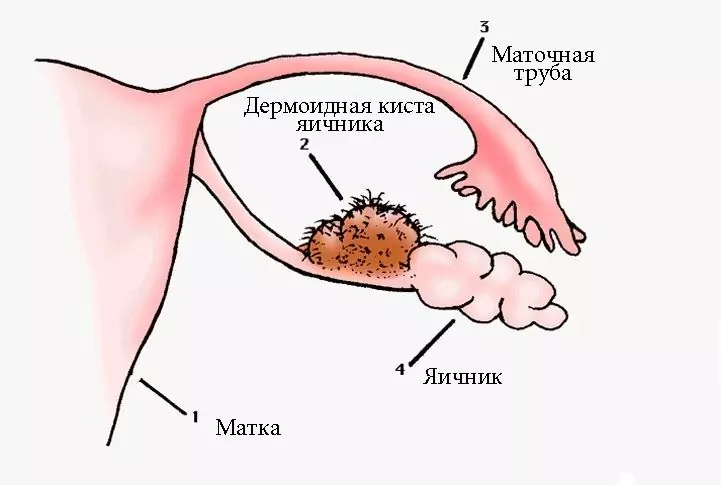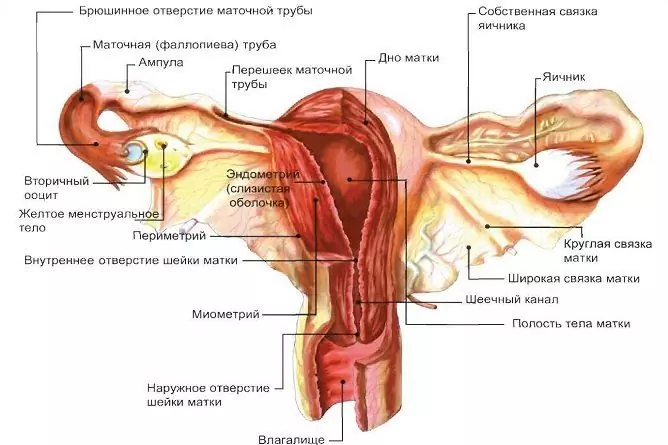- Author Rachel Wainwright [email protected].
- Public 2023-12-15 07:39.
- Last modified 2025-11-02 20:14.
Ovarian cyst rupture
The content of the article:
- Symptoms of a ruptured ovarian cyst
- The consequences of a ruptured ovarian cyst
- The reasons
- Treatment
- Video
A ruptured ovarian cyst is a serious condition that requires immediate hospitalization. An ovarian cyst is a benign abdominal mass and in most cases does not pose a threat to the patient's health. The appearance of a neoplasm depends on the phase of the menstrual cycle (the period of ovulation in particular). There are several options for cystic formations:
- follicular cyst;
- luteal cysts;
- endometrioid cyst;
- corpus luteum cyst;
- dermoid cyst.
Each form has its own characteristic features and its own treatment model, but any of them can give a break as a complication.
Attention! Photo of shocking content.
Click on the link to view.
Symptoms of a ruptured ovarian cyst
The rupture is manifested by the classic symptoms of an acute abdomen. This is a syndromic complex related to life-threatening conditions, and in 80-90% requires an operation (diagnostic laparoscopy or laparotomy).
List of symptoms:
- Severe pain in the lower abdomen. It arises sharply, without a prodromal period, against the background of complete well-being. The differential difference from appendicitis is that a woman can name the exact hour of the onset of the symptom. Pain in the initial stages is often localized in the pelvic cavity (projection of the uterus). As it progresses, it rises, capturing the lower abdomen (projection of the ovaries - the right and left iliac regions). In this case, physical examination (palpation) will reveal all the classic peritoneal symptoms (Shchetkin - Blumberg, Sitkovsky, Razdolsky, Voskresensky).
- Bleeding. The intensity of blood loss will depend on the anatomical location of the follicle that burst, and the number of vessels feeding it. With a pronounced vasculature in the place of rupture, blood will intensively enter the abdominal cavity and the cavity of the ground pelvis, and cause irritation of the nerve roots of the peritoneum.
- Nausea and vomiting.
- Diarrhea or, conversely, stool retention.
- With the involvement of the bladder - pain, increased urination. Changes in laboratory data are possible, which can lead to difficulties in diagnosis.
- Symptoms of intoxication - weakness, loss of consciousness, increased sweating.
- Temperature rise to 38-39 ° С. More often, you can see the temperature curves in the form of a peak (rising to 39 and a sharp decline to normal).
- Tachycardia and a decrease in blood pressure in response to increasing intoxication, centralization of blood circulation due to bleeding and an increase in temperature.
One possible symptom may be bloody discharge from the uterus. This symptom is not typical and requires differential diagnosis with conditions such as ectopic pregnancy, endometriosis, squamous cell carcinoma.
An emergency ultrasound of the pelvic organs is needed in order to exclude ovarian apoplexy, and a repeated consultation with a gynecologist to determine further treatment tactics.
The consequences of a ruptured ovarian cyst
With timely diagnosis, the consequences can be minimized. Among the serious complications of the rupture itself are:
- Peritonitis. Severe purulent diffuse process in the abdominal cavity associated with damage to the sheets of the peritoneum. It can be serous, purulent, fibrinous, hemorrhagic, depending on the exudate (with rupture of the ovary, hemorrhagic is more common). It can be delimited (at the initial stages) and not delimited (in the later stages). In the case when peritonitis is limited to the pelvic cavity, that is, to one anatomical region, it has the character of a local process, but as it progresses, it goes first into the widespread (2-5 anatomical areas), and then total (the entire abdominal cavity). It manifests itself with all the clinical symptoms of an acute abdomen.
- Failure and subsequent removal of the ovary. When the cyst is located directly in the ovarian cavity, it is necessary to remove it completely.
- Early and late adhesive intestinal obstruction. This variant of complications is associated with the occurrence of constrictions over the intestinal loops (the cause may be insufficient lavage during surgery and residual fibrin on the intestinal walls). For prevention, physiotherapy procedures are prescribed every six months for two subsequent years. Divided by time of occurrence (earlier or later 2 weeks after surgery). The clinical picture is presented by symptoms of an acute abdomen, vomiting and stool retention are more pronounced.
- Adhesions in the area of the fallopian tubes, which extend from the affected ovary (the cause may be insufficient sanitation of the cavity). They can cause dysfunction and problems with conception due to impaired patency of the fallopian tube.
- Severe forms of anemia, which are associated with the need for blood transfusion. Only with severe bleeding after surgical suturing of a burst ovarian cyst is blood transfusion indicated. Laboratory data for blood transfusion - hemoglobin below 80, erythrocytes below 3 * 109 mmol / l, low coagulogram values.
- Pronounced disruptions in the menstrual cycle, leading to difficulties with conception or infertility. This development option is possible in the presence of hormonal dysfunction. In other cases, since the ovary is a paired organ, severe disorders are rare.
- Sepsis. It develops when a bacterial infection is attached. In this case, there is a total infection of the blood with the transition to multiple organ failure. It is extremely rare when the ovary ruptures.
The consequences occur in 5-10% of all women. Fatalities are extremely rare (1: 10000).
The reasons
The causes of ruptured ovarian cysts are not always clear-cut. There are a number of predisposing factors:
- Sexual intercourse. In most cases, we are talking about non-traditional (the use of additional devices) or criminal (rape) forms of sexual intercourse.
- Intense physical activity. In this case, a woman may not immediately determine exactly the rupture of the ovary, writing off the pain in the abdomen for overstrain of the muscular frame.
- Blunt trauma to the abdomen. It occurs when falling from a height and may be accompanied by ruptures of other internal organs (spleen, liver, bladder).
- Hormonal regulation disorders. In this case, the patient has a history of multiple data on ovarian cysts, which appear periodically and spontaneously disappear. The main diagnosis is chronic.
- Congenital pathologies. These include polycystic ovary disease and, as a rule, they resort to surgical intervention much earlier than ruptures, carrying out a planned operation after identifying cysts that have a risk of rupture.
- Inflammatory processes in the abdominal cavity. In particular, we are talking about an atypical located appendicitis (pelvic location). When the inflamed vermiform appendix comes into contact with the ovary, in which there were already signs of a cyst, a transition of infection may occur.
If the patient has a history of cysts, the above risk factors should be avoided.
Treatment
If the cysts rupture, the patient is hospitalized in the intensive care unit, and then transferred to the operating room. In the intensive care unit:
- stabilizes hemodynamic readings (blood pressure, heart rate);
- with significant blood loss, erythrocyte mass, plasma, platelet mass are transfused;
- stabilize blood oxygenation (saturation at least 90%);
- carry out symptomatic therapy (antibiotic therapy);
- drugs are administered to stop bleeding (Heparin, Gamma-aminocaproic acid, Vikasol).

A ruptured ovarian cyst is treated only with surgery
There are several options for surgical intervention:
| Operation name | Description |
| Laparoscopy | Minimally invasive surgical technique, which is carried out through 3 punctures. High-tech devices (video cameras) are used to inspect the abdominal cavity from the inside and to possibly close the gap with sutures. Used in relatively simple cases (uncomplicated rupture, minor internal bleeding). High cosmeticity of operations. |
| Laparotomy | Median laparotomy with a significant amount of intervention (large incision, wide access) is used more often. This is done to thoroughly flush the abdominal cavity with saline and prevent complications. This type of surgery is performed with total and extensive gaps. |
Possible types of operations:
- unilateral ovariectomy (removal of the ovary on one side);
- ovarian resection (removal of part of the ovary while maintaining its function);
- unilateral tubo-ovariectomy (removal of the ovary and fallopian tubes on one side);
- unilateral tubo-ovariectomy with resection of the second ovary (occurs when there are cystic changes in two ovaries and there is a suspicion of multiple ruptures).
At the end of the operation, a drain is inserted for 2-4 days to flush and drain the abdominal cavity, which prevents fluid accumulation and repeated laparotomies.
In most cases (90% or more), ovarian function is fully restored in 2-3 months.
Video
We offer for viewing a video on the topic of the article.

Anna Kozlova Medical journalist About the author
Education: Rostov State Medical University, specialty "General Medicine".
Found a mistake in the text? Select it and press Ctrl + Enter.






